 Task Group Materials
Task Group MaterialsMidong Industrial Park was established in September 2005. As a large-scale regional chemical park, it represents the same opportunities for investment and development as the two state-funded economic and technological zones in Urumqi. The entire area is around 108 km² (see Fig. 5). In September 2007, the pilot plan to promote circular economy in Midong Chemical Park funded by the Trade and Economic Commission of the Autonomous Region of Xinjiang was approved and Midong has become one of the first circular economy parks in Western China. In May 2010, around 300 companies with 20,000 employees were located at Midong Chemical Park. In 2009, the added value of the industrial park was 33 billion RMB, which is 92 % of the whole Midong region.
Two questionnaires were created in order to investigate the development of circular economy in the industrial park and to get an idea of the opinions and behaviour of important entrepreneurs in the park, one for the individual companies and a second questionnaire for the industrial park. 12 circular economy pilot projects were set up, involving 7 companies. Furthermore, the information collected allowed significant material flows and relationships between the individual companies to be drawn.
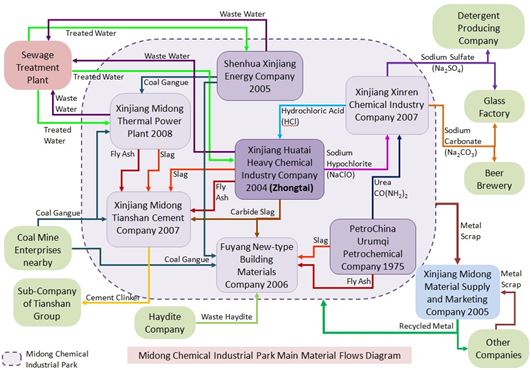
Midong Chemical Industirla Park Main Material Flows Diagram
In order to pursue a sustainability-oriented waste management approach which involves the control and influence of waste and materials flows both within and between companies, these flows must be made transparent and clearly depicted. Here, the company’s current data on waste and materials forms the basis for such illustrations. By compiling data using a specialized waste management software, weaknesses and potentials for improvement within and outwith companies can be identified and defined and a transparent, continuous process of improvement will be initiated. In contrast to collecting data on material flows through surveys, which only provide data to certain points in time, the software offers users the possibility to continuously compile data and carry out analyses.
In order to put the aforementioned advantages of such an approach into practice, the Sino-German partners decided to build a waste management software into the project, which would continue to contribute to increasing the sustainability of industrial waste management even after the project had come to an end. A detailed market analysis showed that such a waste management software is not yet available on the Chinese market.
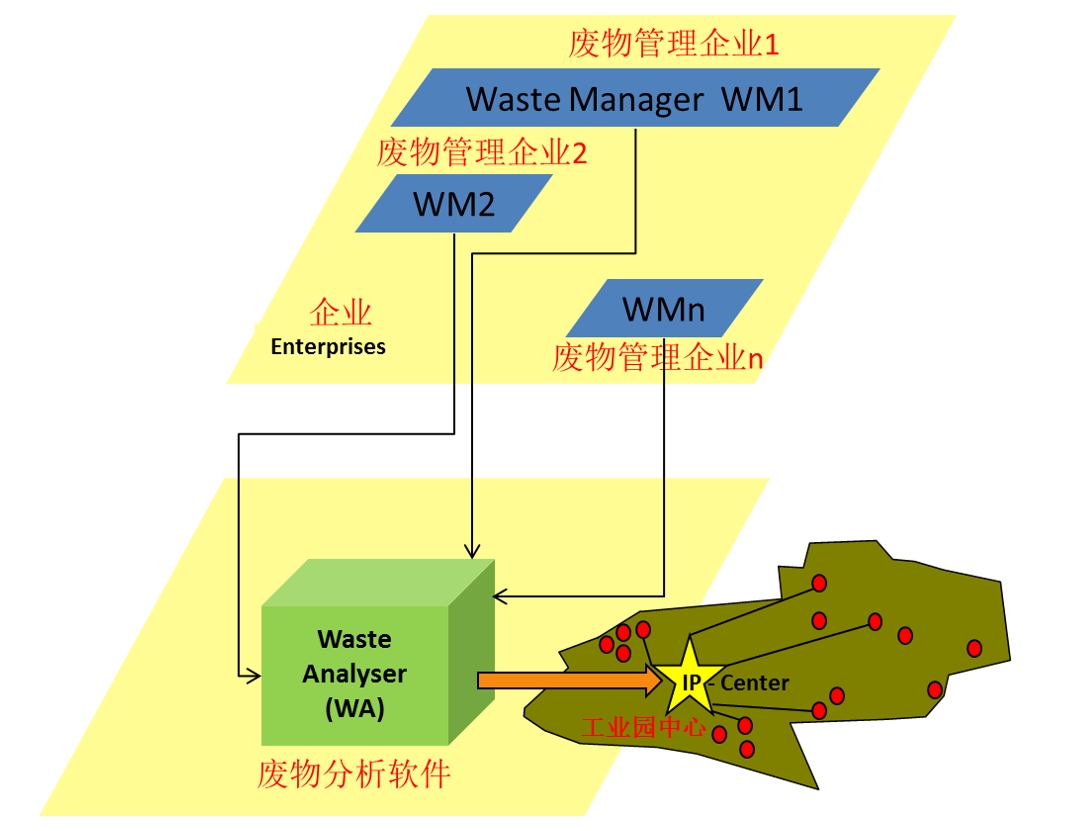
Implemtation of a Wastemanagement Software in the Industrial Park
The Chinese and German partners decided to take on the development of an appropriate software themselves and created an instrument that complied with internal requirements relating to relevant waste information and the analysis of individual enterprises, as well as the needs of coordination between companies (e.g. through a central industrial park management) involving the transfer of materials and information. The waste management software application is based on the well-known Microsoft Access programme, which is part of the Microsoft Office Package and can thus be easily integrated into the existing IT environments of the participating companies. The Sino-German development of the software begun in the autumn of 2009, based upon a software already developed by IUWA for German companies. The current version was tested at by the Xinjiang Academy of Environmental Protection Sciences, the Chinese partner of the “Materials” task group, at the end of 2010 and sent out to individual companies as a betatester.
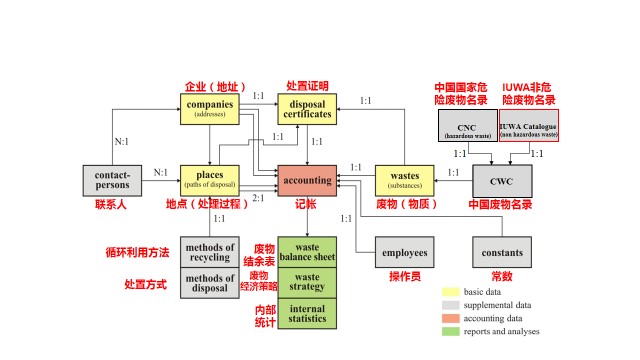
Entity Relationship Model of the IUWA Wastemanager
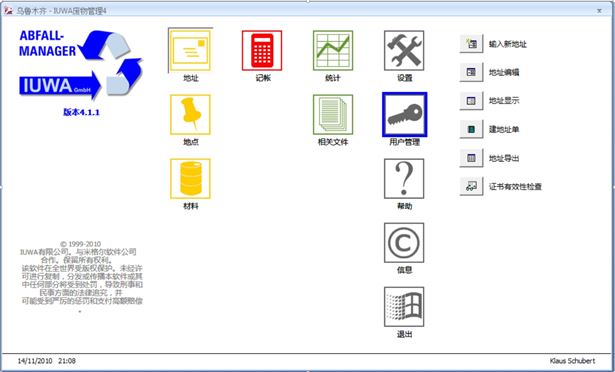
Main menu of the Chinese version of the IUWA Waste Manager
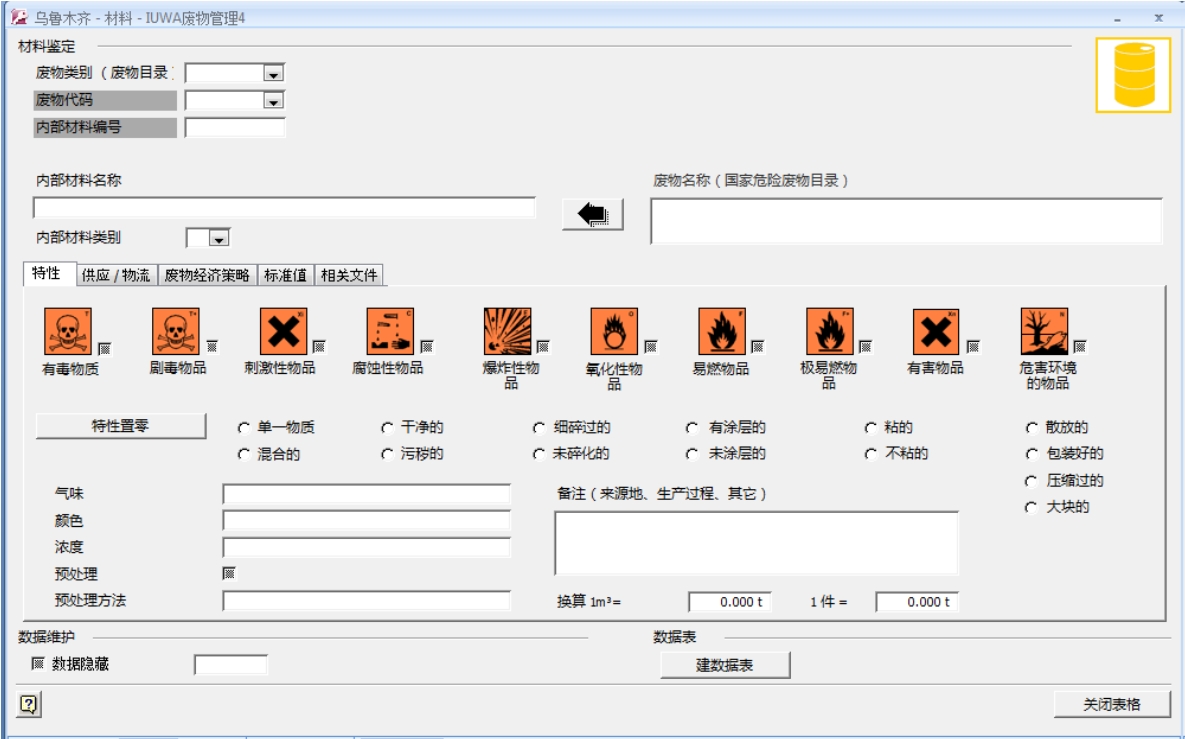
Materials interface with the Chinese National Catalogue of Dangerous Waste
The four main interfaces make it possible to enter and save data relevant to waste management. The software also allows users to enter key information such as: the addresses of their own company, disposal and transport companies and of the different authorities; the materials that are classed as waste or secondary raw materials within the company; the places through which the materials during their lifetime, both within and outwith the company (from the “production site” to interim storage to the disposal or recycling site); the certificates that function as the legal basis for and documentation of disposal.
The waste generated by Xinjiang Province and thus by Midong Industrial Park are still today deposited at landfill sites – recycling virtually does not take place. Landfill sites, however, are not a practical approach in the long-term for solving the waste problem and burning the waste would probably also only be a second-best alternative, due to the emissions given off and the remaining residues with high pollutant concentrations. The best solution, therefore, remains trying to avoid the generation of waste, supported by a functioning recycling system of used materials that then introduces them back into production cycles, a method that is both economically and ecologically acceptable. The order of priorities of waste avoidance before recycling of waste before disposal of waste in modern waste management and circular economy is well known in China and has been reflected in recent years in various laws and regulations such as the Law of the People’s Republic of China on the Promotion of Circular Economy, specifically in chapters III and IV. The current 12th Five Year Plan (2011-2015) contains challenging and wide-reaching goals to improve circular economy and to generally promote sustainable development. It is however difficult to meet such goals in today’s China, as the country still lacks the necessary basics such as a standardized classification system for non-hazardous waste, like the European Waste Catalogue. Especially in the area of non-hazardous waste, the economic and ecological potentials to be gained through the avoidance of waste and reuse of raw materials are high. In order for measures to be taken, however, for example to avoid the generation of waste, and to identify the best methods of recycling, reliable information in the form of legal classifications and characterisations of all these different kinds of wastes is needed. We have therefore built a Chinese catalogue for non-hazardous waste into the IUWA Waste Manager to complement the one for hazardous waste, in order to increase the possibilities of recalling information on all types and quantities of waste, both within and between different companies. The basis for the development of the Chinese catalogue for non-hazardous waste were the lists from Appendices VIII and IX of the “Basel Agreement” in which the types of waste categorised as non-hazardous for the purpose of the agreement are listed.

Catalogue of non hazardous waste
The key infrastructure areas of energy, water, wastewater and waste are counted among the many challenges to be addressed by urban management in fast growing megacities such as Urumqi and also form the focus of the RECAST Urumqi project. In order to adequately meet these challenges, a reliable basis of data on the above areas is essential. The geographical area of examination of this research comprises the former towns of Miquan and Dongshan, which now together form the administrative district of Midong, which lies to the north-east of Urumqi. The merging of two administrative districts, that were previously under the control of separate governments and who favoured widely differing approaches to solve similar problems, led to a poor quality of heterogeneous and thus highly incompatible data, which created additional problems for Midong. In this respect, the creation of a homogenous and high-quality data basis is of great importance to Midong.The Task Group Materials carried out two household surveys on the behaviour and awareness of private households in relation to the areas of energy, water and waste. The household surveys were carried out in 6 parts, corresponding to the six new districts of Midong, which previously belonged to Miquan and Dongshang.

Midong: C1=Dipang, C2=Tonghui, C3=Bafang, C4=Yuanyi, C5=Hongqiao, C6=Minzhu
The corresponding questionnaires were designed by IUWA in close cooperation with our Chinese partners, to ensure that it clearly fitted the local milieu. In preparation for the face-to-face interviews that formed the basis of the surveys, the Chinese interviewers were first required to take part in capacity building training over several days. The questionnaires themselves consists of approx. 70 questions (open and closed), which are divided up into 7 sections. In addition to the key topics of waste, wastewater and energy, the questionnairealso contains questions on the living environment and situation of participants, their personal awareness and perception of environmental problems and also any recommendations or suggestions they might have in this context. The section on waste contains questions on opportunities for recycling, refuse bins, types of disposal and waste fees. Suggestions for waste disposal and how they are rated is also covered in this section. The central questions of the section on water relate to water quality, origin, consumption quantities and costs. Continuing in this vein, the questions on energy relate to usage levels and costs, types of energy used, heating patterns and energy saving measures. The questionnaire concludes with suggestions for the improvement of diverse environmentally relevant areas. The survey provided new knowledge on the behaviour of households in using energy and water, in generating and separating waste and in their general environmental behaviour and awareness. The areas which were rated by participants as particularly problematic are air quality with 83%, water quality with 66% and waste disposal with 49%. Of the total number of participants, 55% would separate waste without restriction if they knew how and if it were advantageous to them. This shows the need for better information on recycling (starting with schools), better infrastructure and the introduction of waste fees on a user-basis (currently calculated together with water usage). More information and education is also needed in the area of sustainability – only 6% knew what this term means. With 48.8m³, water usage per household per annum is very low for Chinese standards. 74% attributed this economic use of water to rising prices. Rising prices were also the reason for 72% of participants increasing energy-saving measures.
